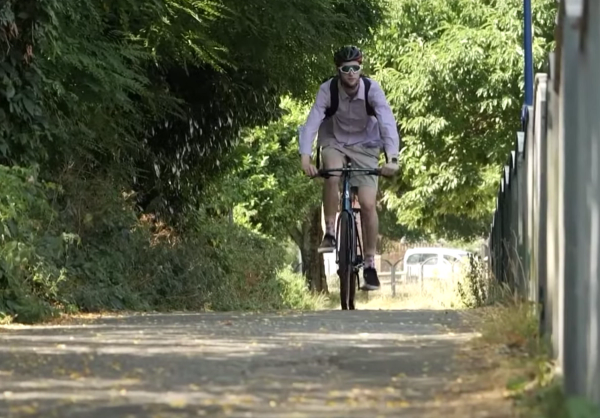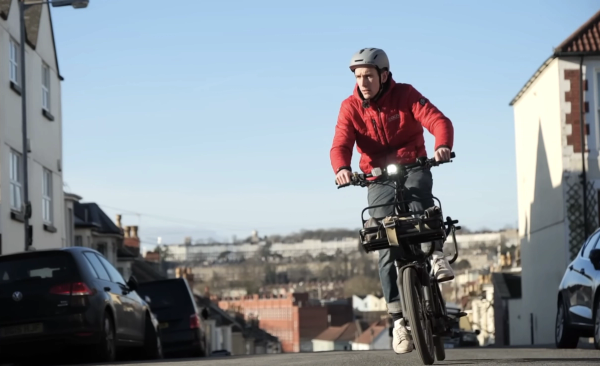Top tips for cycling to work: Beginners guide to commuting by bike
If you’re thinking about using your bike to ride to work for the first time, here’s everything you need to know to ensure a safe and comfortable commute to the office
Tom Hallam-Gravells
Online Production Editor
Taking on a commute to work is one of the best ways to unlock the benefits of cycling. It will get you out in the fresh air, relieve stress after a tough day in the office, remove the woes of being stuck in bumper-to-bumper traffic and, most importantly, it's simply lots of fun.
Kickstarting your cycling commute can be daunting at first, though. While it’s best to simply crack on and try it out, there are some things you’ll need to be aware of and plan for, all of which will make your commute by bike safer, more efficient and fun.
To help you prepare for your commutes by bike, we’ve pulled together this in-depth guide. From safety tips and route planning to equipment. Here’s everything you need to know to get started.
Read more: I can’t cycle to work, or can I?
Benefits of cycling to work
Before we delve into the finer details of commuting, you may still need a little extra convincing that a commute by bike is the way to go. We may be biased, but we believe a cycle commute is great because it doesn’t only have benefits for you, but also for wider society.
Governments around the world are now investing in cycling infrastructure to encourage more people to take up commuting by bike, all of which reduces the number of cars on the road and, in turn, carbon emissions. One study by the University of Oxford found that people who swap their motor vehicle for a bike or walking for one trip per day “reduce their carbon footprint by about 0.5 tonnes over a year”. The effects, according to lead researcher Dr Christian Brand, would be huge if more people adopted active modes of transport: “If just 10% of the population were to change travel behaviour, the emissions savings would be around 4% of lifecycle CO2 emissions from all car travel.”
There have also been many studies published that highlight the personal benefits of commuting by bike, which range from reduced stress and increased energy, while one study in the British Medical Journal points to a reduced risk of dying from heart disease or cancer.
So, if you were in any doubt, the impact of commuting by bike can be significant.
What is the best bike for commuting?
By now, you’re hopefully sold on the virtues of commuting by bike, which leads us on to the practicalities of taking those first pedal strokes. The most obvious necessity for this will be a bike, and there are many different types to choose from.
Commutes can come in all different shapes and sizes, so you’ll need a bike that primarily meets the terrain that you will be riding (we’ve got more information on route planning below). For example, you may stick solely to smooth tarmac, in which case a city-focussed hybrid bike is usually your best bet. Those with a penchant for speed may use road bikes, while others may want something suitable for canal paths or even gravel.
Here’s a full breakdown of the different types of bike and what they’re best suited for.
Hybrid bikes
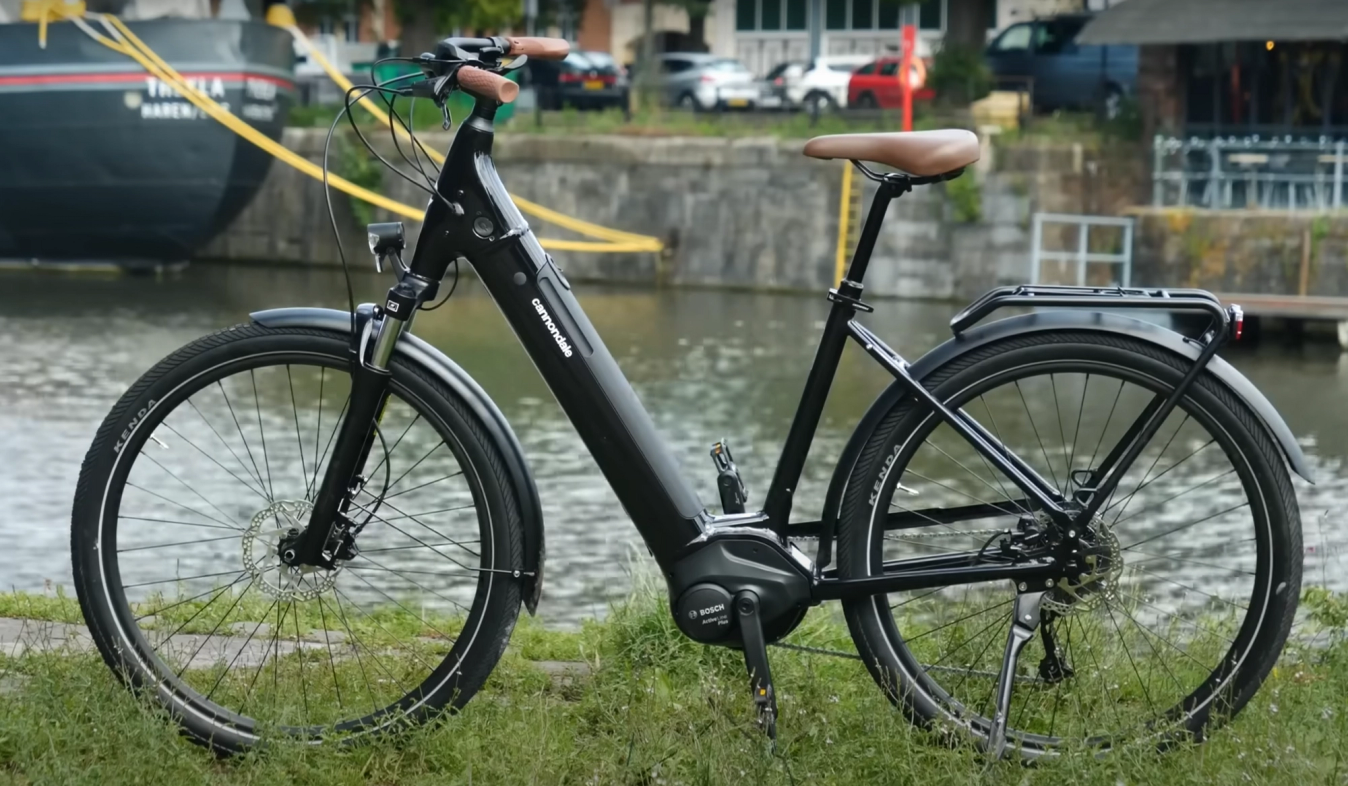
© GCN
Hybrid bikes are designed for urban riding
These are one of the most popular options for commuting, as they’re specifically designed for city use. This will usually include practical features like racks or mounts for racks, a more relaxed geometry, plus mudguards. Hybrid bikes usually have flat bars too, as well as fairly chunky tyres to handle the rugged tarmac or smaller potholes - hopefully you’ll avoid any larger potholes.
Road bikes
Built for speed, road bikes are best suited for longer commutes where you will be able to lap up the kilometres/miles faster. They have skinnier tyres and dropped handlebars, plus more aggressive geometries that put riders in a slightly more aggressive position on the bike. This position can be uncomfortable if you’re not used to it.
Mountain bikes
Mountain bikes are built for off-road terrain, so they’re not ideal for the smooth tarmac of towns or cities, although some riders still prefer them. They will thrive if you’re the adventurous type who wants to add an off-road detour to their ride.
Gravel bikes
A fairly new addition to the roll-call of bike types, gravel bikes represented a niche category only 10 years ago, but now they’re one of the most popular types of bike available. As the name suggests, they’re designed for lighter off-road terrain like loose gravel and blend both road and mountain bike characteristics, such as dropped handlebars and wider tyres, while some even have suspensions. Gravel bikes are arguably the most versatile type of bike on this list, at home on both tarmac and off-road terrain (albeit, nothing too rugged).
Read more: What's the difference between road and gravel bikes?
Folding bikes
Folding bikes are perfect for those who want to mix cycling with public transport on a commute. They’re designed to be easily folded down into a compact shape, whether it be to carry or store them. This also makes them handy if you’re short on space at your house or lack storage facilities at your place of work, as they can easily slide under a desk without taking up too much space.
Electric bikes

© GCN
E-bikes have motors that provide assistance as you pedal
All of the different types of bike listed above are also available as e-bikes. An electric bike contains a motor that will provide assistance, either through the cranks as you pedal or through a throttle on the handlebars - the latter type is regarded as a moped in some countries and is subject to different road laws. They've become incredibly popular as they help to make cycling more accessible, whether it be by helping a cyclist to conquer hills, terrain or distances that wouldn’t usually be possible. Most e-bikes also have a significant range of at least 20km, but often over 50km, so more than enough for a ride to work.
Read more: Electrify your commute: How to cycle to work on an e-bike
Is the Cycle to Work Scheme worth it?
Buying a bike can be a significant investment but some countries have schemes to help, such as the UK’s Cycle to Work scheme.
It is a UK government tax initiative that gives employees a cost-effective way to get a brand-new bike and accessories without an up-front cost. Once you’ve picked out the bike and gear you want, your employer effectively buys the equipment and then you pay for it through regular salary sacrifices. Best of all, these sacrifices are taken pre-tax, meaning you save either 30% or 40% - minus the fee to transfer the bike or equipment into your name - compared to buying a bike through regular means.
The scheme used to be limited to £1000 but that has since been scrapped, although your employer may have its own limit.
For those who want to get serious about cycling to work, it offers one of the most cost-effective ways to buy a bike.
Read more: Everything you need to know about the Cycle to Work scheme
Essential commuting gear, accessories and equipment to upgrade your ride to work
While a bike is the obvious essential for cycling to work, there are some accessories and equipment you should consider, which range from safety essentials to nice-to-haves.
Always wear a helmet
Depending on your country, wearing a helmet may not be a legal requirement, but you should never ride without one. It can sound like an overused cliche, but a helmet really can be a life-saver in a crash. Don’t opt for the cheapest option, either. Cheap helmets will lack the best safety technology, such as MIPS (Multi-Directional Impact Protection System). Some helmets will have additional features to keep you safe too, like integrated lights.
Be seen: Use front and rear lights as a minimum
Be safe, be seen. It’s another saying you will have heard, but it’s also one that rings true. It can often be hard for motorists to spot cyclists, especially in low-light conditions. They’re much more likely to see you if your bike is home to lights. The same can be said for distracted drivers, whose attention can be caught by a flashing light.
A front and rear light is the bare minimum, but it’s best to follow a ‘the more, the better’ type of philosophy. There are lights that attach to clothing, shoes and helmets, all of which will help you be seen.
Read more: How to choose the right bike lights
Mudguards
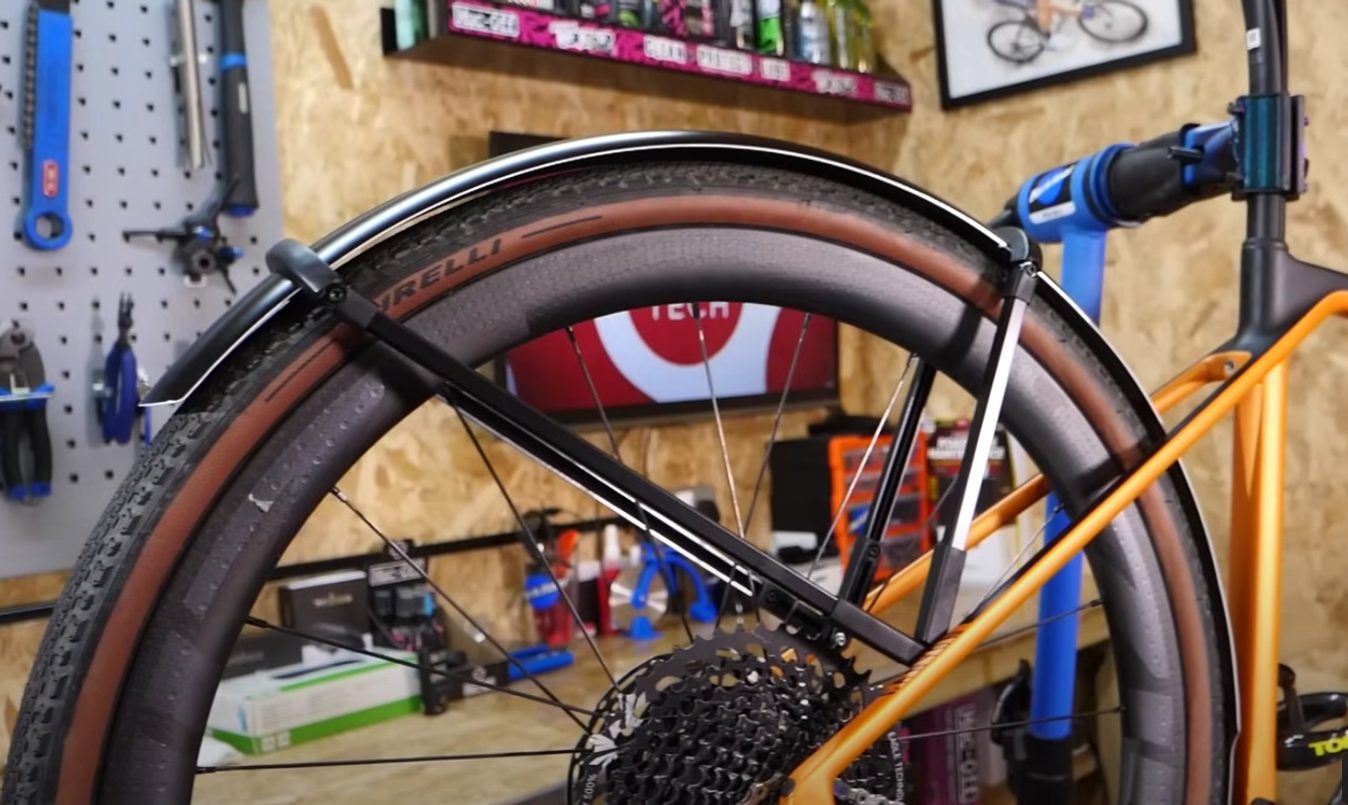
© GCN
Mudguards will protect you and other commuters from splash
If you’re lucky enough to live in warmer climes where rain is a rarity, then mudguards may not be necessary.
For the rest of us, it is something that we will inevitably have to contend with when commuting, sometimes a lot more often than we’d like.
Riding in the rain will be a lot more enjoyable if you use mudguards. These can be attached above the front and rear wheels to prevent any splash. Fail to use them and you may find yourself ruing the decision as you walk into the office caked in grime.
Any other commuters who are unfortunate enough to find themselves riding behind you also won’t appreciate the splash. So, it’s best for everyone if you use a mudguard.
Some bikes have mounts that they can be attached to. If yours doesn’t, there is also the option of clip-on mudguards too.
Racks
We’re guessing that, if you’re cycling to work, you’ll have some things to carry with you. One of the most convenient solutions is a bike rack.
Racks aren’t a solution everyone can take advantage of and are dependent on your bike. Some bikes, mainly hybrids, have mounts for racks that come with ones already attached.
Other bikes don’t have space for racks at all.
A bag
Alternatively, you may need a bag.
This seems like a fairly mundane addition to a list of commuting essentials, but it’s more important than you may think. Rather than using a standard backpack that you have lying around, it’s worth considering a dedicated commuting backpack.
For a start, your bag will probably be home to important things that you’ll need when you get to work, like a laptop or clothing. Many dedicated backpacks for riding or commuting are waterproof, so you won’t need to worry about these things getting soaked.
You’ll also need a bag with straps that wrap around your chest to secure it in place, otherwise the straps can droop off your shoulder. This can be anywhere from irritating to outright dangerous.
Commuter cycling clothing: What's best to wear riding to work?
Contrary to some popular beliefs, you don’t need to spend a fortune on lots of fancy cycling clothing. In fact, you can often cycle in your work clothes, although you’ll need to consider some additions to help keep everything protected - you don’t want to arrive in work soaked or caked in mud. Be mindful that commuting can be sweaty work, though, so it may be best to carry your work clothes in a bag to change into when you arrive.
Some cycling-specific clothing can make a big difference on a ride too, specifically bib shorts with chamois pads. These pads are designed to provide cushioning for and reduce pressure on your rear end - numb bums can be one of the unwanted side-effects of cycling.

© GCN
You don't necessarily need dedicated cycling clothing
Overall, try to wear what is comfortable. Here are some more things to consider:
- Bright clothing - Wear bright clothing wherever possible, preferably that is fluorescent or has fluorescent strips. Dark clothing can be hard for motorists to spot, making you more vulnerable.
- Waterproof clothing - In some parts of the world, like the UK, it rains…a lot. You can be forgiven for taking the car on such days, but that’s not an option if you’re already at work. That’s why it’s important to carry waterproof clothing with you. It won’t always be necessary, especially in the summer, but is essential throughout the wetter months. Check the weather forecast too so that you have an idea of what lays ahead.
- Protect your hands and feet - Exposed to the elements, hands can become numb in cold weather. Beyond the discomfort, it’s also a safety risk as it could impair your ability to operate the brake levers. So, carry gloves with you. These should preferably have waterproof properties too. The same can be said for the feet and there are dedicated shoe covers for cycling that will help to keep your feet toasty and dry.
Read more: What gear do you need to start cycling?
How to plan a route for a commute
A route can make or break a commute. Pick a bad one and it may be enough to put you off commuting completely.
That’s why you should take a little time to plan a route ahead of time. Even if you know your way around, your perception of a good route from driving may differ to when you’re cycling. In fact, you should avoid any high-traffic areas that you would usually take by car.
Riding to work on your bike gives you the freedom to go pretty much wherever you want, so try and pick a route that looks like a pleasant place to ride, avoiding traffic hotspots even if it means a slightly further distance.
Many urban centres have cycling infrastructure such as bike lanes, so try and take advantage of this wherever possible. Speak to colleagues or friends who commute by bike, as they’ll often be aware of these bike lanes.
When it comes to sitting down and plotting out the route, consider recruiting the help of a dedicated app, like Strava. It contains a heat map feature that shows how regularly cyclists pedal certain routes, which can be a great resource for sifting out the best from the worst areas to ride through.

© Strava
Strava can be a helpful tool when planning a route
Most importantly of all, don’t settle on a route once you’ve planned it. It’s unlikely that you will have plotted the perfect route straight away, so try to observe where other cyclists are riding. It’s worth planning multiple routes too and testing them all out to find which one you enjoy the most.
The key is to settle on one that is as safe as possible, but ideally fun too.
And don’t forget, a commute doesn’t have to stick to smooth tarmac. Heading off-road or on canal paths can be a great way to freshen up the journey and add a little adventure to your day.
Read more: Commuting errors: 10 mistakes all cyclists make riding to work
How can I make my cycle commute safer?
There are a few obstacles that people cite when explaining why they don’t commute by bike, but safety is arguably the biggest. It’s something that every cyclist has to consider, whether they’re riding recreationally or as a part of a commute.
While there is no way to 100% guarantee your safety when riding, there are multiple steps you can take to minimise the risks to both you and your bike. We’ve already covered many, such as wearing a helmet and bright clothing, using lights and planning a safe route, but here are some more top tips:
- Know traffic laws - Understand the rules of the road and make sure you clearly signal to other road users your intentions. Also try to be aware of what other road users around you are doing.
- Check your bike - Your bike will clock up plenty of distance over the course of commuting. Sometimes problems can arise which will need repairing. If ignored, a mechanical issue could leave you stranded on the side of the road or, worst, cause a crash. Check that your brakes work on a regular basis and that key fixings, such as the handlebars and wheel axles, are all secure. If you encounter any problems, sort these as quickly as possible, recruiting the help of a bike shop if necessary.
- Learn basic repairs like fixing a puncture - Mechanical issues occur, whether we like it or not. Your life will be much easier if you know how to fix them. As a minimum, you should be confident in fixing a puncture. If you’re not, we have a guide to help.
- Build confidence - Take things easy on your first commutes. It’s easy to get caught up in the rat race and pedal furiously to work, racing other commuters, but it’s best to build confidence first. Learn to enjoy the commute and familiarise yourself with the route.
- Take some trial runs - If the idea of pedalling to work remains daunting, do trial runs. That way you can test things out without having to deal with the additional stress and demands of work afterwards.
- Have a backup plan - It’s worth having a backup plan in case something goes wrong. Knowing where local train stations are, for example, can be really useful. If you have an insurmountable mechanical problem and don’t have anyone to pick you up, a train or other public transport can save the day.
- Avoid treacherous weather - Once you’ve caught the commuting bug, it’s easy to become a little blinkered and forget that, sometimes, it’s okay to take the car or public transport to work. If the weather is bleak or the conditions are dangerous, such as being icy, it is often best to give up on a bike commute for the day.
How to lock a bike securely?
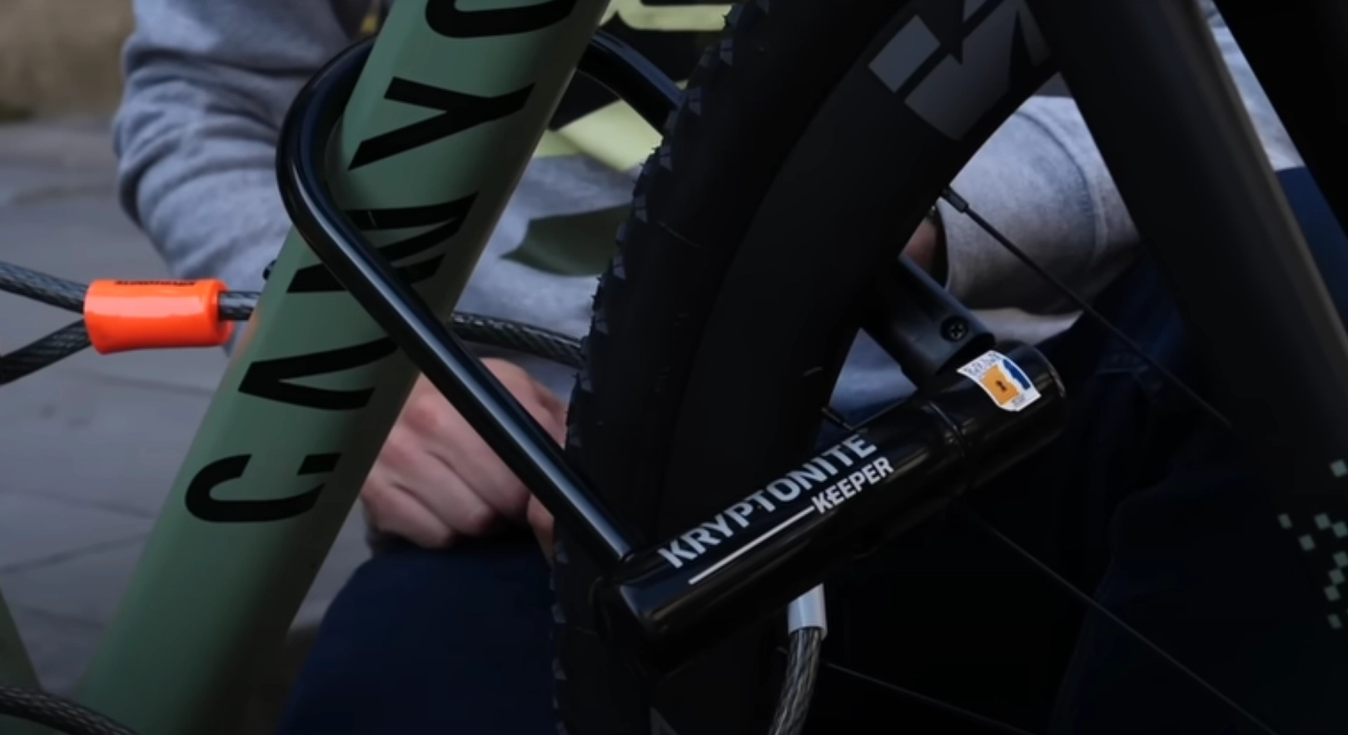
© GCN
Always make sure your bike is securely locked
We could have included this in the previous section, but it’s a really important point that deserves to stand alone.
Bikes are one of the top targets for thieves. The high value that makes your bike so precious is what makes it an attractive proposition for criminals, who are often willing to go to extreme measures to get what they want.
That’s why a cheap, flimsy lock won’t cut it. To keep your bike secure, you will need a lock with an approved safety rating. Sold Secure is one of the most popular ratings systems and each of its tiers relates to the tools that would be required to break the lock. The higher the tier, the better.
Use more than one lock too. Beyond protecting your bike, they act as a deterrent. A thief is more likely to target a bike with one lock than multiple.
When locking your bike, follow these key rules:
- Lock it to something secure - It sounds obvious, but many cyclists have locked their bike to a seemingly immovable object, only to realise the lock could be lifted right over it. Worst still, if it’s a particularly flimsy object, thieves may simply cut through it rather than your lock. So, pick an immovable object that can’t easily be cut.
- Wind the lock around multiple components - Another common mistake is to put the lock around the rim of a wheel. The only problem is, a thief can remove the wheel and take the rest of the bike. Try to make things as difficult as possible for a would-be thief by wrapping the lock around multiple parts of a bike. This will also make it more taut and harder to cut. Again, using multiple locks will help here too.
- Take advantage of CCTV - CCTV cameras don’t just capture footage, they act as a deterrent. If your bike is locked in sight of a camera, it should offer another layer of protection.
- Busy locations - Always lock a bike in a busy location. This can seem counterintuitive as more people, so more potential thieves, will see it. However, it is much more risky to steal a bike in an area with lots of witnesses. A bike hidden away down a dark alley may be harder to spot, but it’ll be easier for a thief to steal without being interrupted.



.png?w=600&auto=format)










.jpg?w=600&auto=format)


